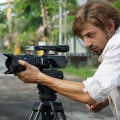Avoiding audio jump cuts
Part of 'What the editor requires' series.
Just as important to make sure the pictures you film are cuttable, you also need to make sure the sound is continuous.
Background noise
Always check for background noise, such as running water or traffic noises which may cause sound jumps in the editing. You may not notice it but there's always a lot more going on than you think. Turn of background sounds such as fridges, televisions, radios and phones. Always wear headphones and listen carefully while filming.
Recording a 'wild track' of the atmosphere sound can help the editor to iron out audio mismatches. Just let your camcorder record the background noise for a few seconds. You can provide information about your wild track on the video tape or disc.
Audio continuity
Creating good footage also includes making sure audio continuity is guaranteed. When the editor has to cut shots where the acoustics change every time, the end result will probably not be good. An example of a common problem is an interview where a fridge motor keeps turning on and off. While you may not notice this while shooting, it will be very difficult to edit the interview. It may even be impossible to make the audio sound continuous now!
Your Comments
Add your comment:
Tagged
More Camerawork
Provide cutting points for the editor
If you want to make your editor happy, you need to create places in your footage where he can make cuts. It will make editing so much easier and the end result so much better if you think about editing while filming.
A moving shot: performing clean A to B movements
A good moving shot is performed in such a way that it does not draw the audience's attention to the camerawork. When you are filming, you have to plan every shot you make before pressing the record button. Planning a moving shot means you'll actually have to plan two shots: the A-shot and the B-shot.
Creating good B-roll footage
The B-roll refers to supplemental or alternate footage that is used to intercut with the main shot in an interview or documentary. You need this footage to get out of any tricky editorial situation, and to cover long, visually uninteresting interviews.
Popular
The 7 Steps To Becoming A Professional Cameraman
Television has continued to hold it's ground and collaborated with the World Wide Web in order to take a huge leap into the virtual world too. This has opened up even more doors for cameramen who wish to enter into the broadcast television industry.
Why Are We Still Filming In Framerates Designed In The 1920's?
The frame and field rates that have been used for television since the 1920s cause problems for motion portrayal, which are increasingly evident on the large, high-resolution television displays that are now common.
Deciding On Which Camera To Use For Your First Documentary
Choosing the right camera to film your documentary can be quite a difficult task. But it's also a very important one, so i've made this list of things to consider when buying the camera for your documentary.
How to use shot pacing to tell a story more effectively
The job of an editor is to cut an item to a fraction of the original running time of the footage. The editor will have to match two rhythms: the rate of shot changes, and the continuity of the action that is captured.














